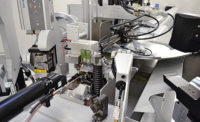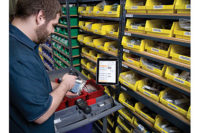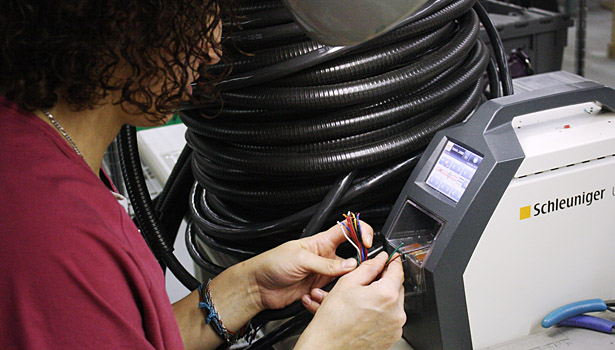A Day in the Life of a Harness Assembly Shop


























Looking at the 12,000-square-foot assembly area of AssemTech Inc. busy with 20 full-time harness assemblers, it is hard to imagine the company’s early days back in 1986—when founder Chuck Hall and various family members assembled harnesses in his garage.
"At the time, I worked in the controls division for AJ Antunes and much of my job involved assembling wire harnesses,” says Hall, president of AssemTech Inc. “The company needed someone to assemble lots of power cable harnesses. I offered to do it for the company after hours. So at night and on the weekends, me, my wife and kids would assemble the power cable harnesses in my garage.”
Hall and his family did this for 5 years while he still worked for AJ Antunes. Over time, they built up their production rate to 500 harnesses per week. In 1991, Hall decided to leave his employer of 10 years and make AssemTech a full-time business. However, the company continues to do work for AJ Antunes.
After leaving the family garage, AssemTech was based out of an empty house for awhile before leasing a unit in an industrial complex in West Chicago, IL, in 1992.
“Initially, we hired three full-time people to do assembly,” says Hall. “My mom supervised production, while my dad made fixtures and also did assembly.”
Company growth has been steady the past 20 years or so. AssemTech incorporated in 1996, established a working partnership with Unicom in China in 2002, purchased the assets of Crest Engineering & Machining in 2006 and opened a sales office in Houston in 2009.
All four of Hall’s children still work for AssemTech. Bonnie runs the Houston sales office. Brannon is operations manager. Michael handles product delivery, and Brianna works at the office periodically as needed.
GREAT TIMES
Business is booming at AssemTech. The company had its best year ever in 2010—producing more than 600,000 wire harnesses—but will surpass that amount by 33 percent to 35 percent in 2011.
Despite these impressive numbers, wire-harness assembly only accounts for about a third of AssemTech’s business. The company also assembles thousands of cable harnesses and lead sets. Other services include harness design and engineering, PCB assembly, custom molding and overmolding, and ultrasonic welding.
AssemTech’s wire harnesses are used nationwide by more than 100 customers serving many industries. About 30 percent of the harnesses are used by manufacturers in the electric power industry. Half of the harnesses are used by manufacturers of industrial machinery and commercial products. ITW Paslode, for example, purchased 140,000 harnesses from AssemTech last year.
AssemTech has nearly doubled its workforce during the past five years. Currently, the company has 39 full-time and three part-time employees. Besides the 20 assemblers, the company has several office workers, four quality control personnel, a quality assurance manager, three PCB assemblers and a wire department supervisor.
AssemTech leases a 15,000-square-foot facility, but Hall is hopeful the company will be able to move into a much larger building within two years. The goal, he says, is to double assembly space and hire many more assemblers.
A HARD DAY’S WORK
AssemTech is primarily a low-volume, high-mix shop, with assemblers making hundreds of harnesses of varying lengths, wires and complexities annually. The harnesses contain wire in thicknesses from 32 gauge to 4 gauge and lengths up to 200 feet. AssemTech uses wire supplied by Unified Wire & Cable of DeKalb, IL.
Occasionally, the shop receives extremely large orders—such as the 140,000 harnesses purchased by ITW Paslode. In those instances, up to 10 assemblers will work on the same type of harness as long as necessary. Assemblers work from 5:30 a.m. to 2 p.m., with a half-hour lunch and two 15-minute breaks.
Many of AssemTech’s current assemblers joined the company from Crest Engineering after Crest was purchased. The company’s assemblers average more than eight years of experience. Turnover is low.
To maximize productivity, assemblers are cross-trained so they can assemble any harness made by AssemTech. Assemblers are trained in blueprint reading, wire prepping, crimping, soldering and quality standards. They must pass written tests before they are company-certified and allowed to perform certain processes. These tests are documented and kept in the employee files. Employees are awarded a certificate of completion as they pass each step.
GETTING AUTOMATED
Currently, assemblers reference blueprints and use wire boards to assemble harnesses. That will change in early 2012 when AssemTech installs several Cirris’ easy-wire and Pin-Sight systems in the assembly area.
The easy-wire system will allow AssemTech to move electrical testing of harnesses further upstream in the assembly process. As a result, assemblers will detect wiring errors earlier—improving quality while lowering overall cost.
Hall says the Pin-Sight guided connector system will improve quality, while simplifying and quickening assembler training. The computer-based system comes with CCD camera, mounting vise, force and sense gauge, software and optional bar code scanner and mini keyboards.
Equally important, AssemTech will soon install enterprise resource planning (ERP) software on its company-wide server. Assemblers and other staff will use all-in-one industrial computers to access the software.
The software is called OmegaCube EPR and is made by OmegaCube Inc. The computers are Lean Machines and are made by American Manufacturing Technologies Inc. Each machine features an encased monitor that houses all necessary hardware, a keyboard and a camera that streams video.
Hall says the video camera will improve productivity by allowing assemblers to immediately show their supervisor the problems they encounter. The ERP software will allow real-time tracking of orders, wire processing, material scrap, invoicing and delivery.
Hall plans to install three machines in the first quarter of 2012 as a beta test for the system. If all goes well, a total of 25 machines will be installed: one in each workstation and five in management work areas.
Looking for a reprint of this article?
From high-res PDFs to custom plaques, order your copy today!



















